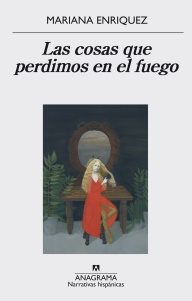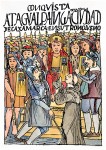More notes
———
Accumulations II [and literature]
Our times are times of the novella. Isn’t it that day by day we question how is it that things have come to this? At the same time reality is coming closer to the durée of “the novel”, since we lived fascinated by the aesthetic contradiction between past and future. If all of this is true, what place would “the novel” hold? For some, like Fredric Jameson, the postmodern is fading away and in its place is now occupied by writing of “itemisation”, the withdrawal (or renouncement) of the attempt to ‘estrange’ “our daily life and see it in new, poetic or nightmarish, ways” (“Itemised”). Karl Ove Knausgaard, Emmanuel Carrère and Valeria Luiselli would be just some items of this list. Valeria Luiselli’s Lost Children Archive (2019) captures in a nutshell what the current status of (Latin-American) fiction in early XXI century is. Yet, one should hesitate to simply take Jameson’s ‘itemisation’ of writing for granted. In a long passage in Luiselli, the main narrator of the novel states that “No one has quite been able to capture what is happening or say why. Perhaps it’s just that we sense an absence of future, because the present has become too overwhelming, so the future has become unimaginable. And without future, time feels like only an accumulation” (Lost Children 103). The narration then enlists all of those things accumulated (months, days, natural disasters, television series, terrorist attacks, divorces, mass migrations, birthdays, photographs, sunrises). The digression happens after the main narrator is asked by one of her children about what, how and when to take a photograph. The fact that, to explain the kid when to photograph, the narrator has to enlist both the emptiness of life, and the failure, of photographing in general when capturing or depicting our experience of time and life, illustrates an impossibility that the narration is aware of. The latter would be that “our ways of documenting the world have fallen short” (103) and consequently as much as experiences and other things are accumulated, the future seems unimaginable, undecidable.
This moment could à la lettre describe what Jameson’s sees in Knausgaard’s sixth book of My Struggle (if not in all the books of the series). Itemisation would be the shift from the aesthetic to the ethical, abandoning the first so that one can as Knausgaard or Luiselli contemplate a “solution to the problem of what to do with [oneself] and [oneself’s] life” (“Itemised”). Hence, for Jameson writing of itemisation is, somehow, the end of the duration of the novel. Since the contemporary novel, as a genre, has to renounce to conjugate the past (what has happened) and l’avenir (what is going to happen), the novel now can merely register a list of items that tentatively would become rereadings, returns to duration. Yet, the novel is hardly a renunciation. In Luiselli, the narration bets for an opening to the future, while hoarding the previous items, “You have to find your own way of understanding space, so that the rest of us can feel less lost in time” (103), tells the mother to the kid so that he would start shooting photographs. There is no duration, but a two folded direction that moves forward in the same direction.
It is not that things have not changed for the novel. Neither it is that the “postmodern” is slowly fading away (if it ever was fully holding sway all over the world). For once, it is true that the novel as “all life is a process of breaking down”, would say Fitzgerald. Something broke in the sphere of the novel, and in the one of the literary. The novel was the genre that better held the hybridity of the new subjects that emerged from the process of so-called primitive accumulation at the dawn of capitalism. While the vogelfrei were attached to their necessity to sell their work in the market, their will was always fugitive. In a same manner the novel was (is) a living contradiction, namely between the writer and their context, the original and the translation, the new and the new. Only the novel knew how to pile together a contradiction. If novellas are cartographies of lines of flight, novels are diagrams of spheres whose functioning lie in opposing semiospheres. To this extend, if the emergence and popularization of novellas (ending of XIX century- and early XX century) marked the shift from industrial accumulation in capitalism and its acceleration, switch and cohabitation to and with algorithm accumulation in the current state of capitalism that we live today, we are not only witnessing the novellation of history, but also the novellation of the novel. If this is true, the contradiction, the main mechanism of the novel, is blurring. The itemisation is not a renouncement, neither the re-disjunction or re-conjunction of duration, “but only a line of flight in the process of being drawn, toward a new acceptance, the opposite of renunciation or resignation —a new happiness?” (Deleuze and Guattari 207), and yet another process of hoarding, a new redirection of accumulation. And still, an opening for heaping history and the novel anew.



 Femininity is all too often defined by the image (and so by the male gaze). Women are reduced to appearance, and judged in terms of the extent to which they measure up to some mythical ideal. Mariana Enríquez’s short story, “Las cosas que perdimos en el fuego” (“Things We Lost in the Fire”), presents a surreal and disturbing counter-mythology that explores what happens when that image is subject to attack, not least by women themselves.
Femininity is all too often defined by the image (and so by the male gaze). Women are reduced to appearance, and judged in terms of the extent to which they measure up to some mythical ideal. Mariana Enríquez’s short story, “Las cosas que perdimos en el fuego” (“Things We Lost in the Fire”), presents a surreal and disturbing counter-mythology that explores what happens when that image is subject to attack, not least by women themselves. In Albert Camus’s celebrated novel of a plague outbreak, he tells us that at a certain point, the citizens of the afflicted North African town of Oran turn to reading. Specifically, they show a “remarkable interest” in “prophecies of all descriptions. [. . .] The local printing firms were quick to realize the profit to be made by pandering to this new craze and printed large numbers of the prophecies that had been going round in manuscript.” But there is not enough material to satisfy demand, and so after searching “in the municipal archives for all the mental pabulum of the kind available in old chronicles,” they turn to “journalists to write up forecasts” that are devoured eagerly to find literary clues to their personal fates.
In Albert Camus’s celebrated novel of a plague outbreak, he tells us that at a certain point, the citizens of the afflicted North African town of Oran turn to reading. Specifically, they show a “remarkable interest” in “prophecies of all descriptions. [. . .] The local printing firms were quick to realize the profit to be made by pandering to this new craze and printed large numbers of the prophecies that had been going round in manuscript.” But there is not enough material to satisfy demand, and so after searching “in the municipal archives for all the mental pabulum of the kind available in old chronicles,” they turn to “journalists to write up forecasts” that are devoured eagerly to find literary clues to their personal fates. A tale of cyberspace, crypto-security and hacktivism set in Bolivia? At first glance, the idea is counter-intuitive. The country is by some measures the poorest in South America (with a per-capita GDP of only just over $8,000) and is more often associated with ancient indigenous cultures than with contemporary hyper-modernity. Yet Information Technology and the Internet, and everything that comes with them, are part and parcel of globalization, which by definition breaks down oppositions between First and Third Worlds, Centre and Periphery. Your cellphone battery may well contain lithium from the salt flats of Uyuni. Global forces shape La Paz or Santa Cruz as much as they do New York or Montreal.
A tale of cyberspace, crypto-security and hacktivism set in Bolivia? At first glance, the idea is counter-intuitive. The country is by some measures the poorest in South America (with a per-capita GDP of only just over $8,000) and is more often associated with ancient indigenous cultures than with contemporary hyper-modernity. Yet Information Technology and the Internet, and everything that comes with them, are part and parcel of globalization, which by definition breaks down oppositions between First and Third Worlds, Centre and Periphery. Your cellphone battery may well contain lithium from the salt flats of Uyuni. Global forces shape La Paz or Santa Cruz as much as they do New York or Montreal. Some posts about the Andean novel, to go with a
Some posts about the Andean novel, to go with a 
 Towards the end of Clorinda Matto de Turner’s Aves sin nido (1889), the mestizo couple Fernando and Lucía Marín, who are in effect the book’s heroes, because they are sufficiently enlightened to take pity on Peru’s indigenous peoples, are shown leaving the highland town of Kíllac where most of the novel’s plot is set. With them are two young indigenous girls, Margarita and Rosalía, their daughters who they are adopting because their parents have died, victims of violence stirred up by the town’s local authorities. There is no place for them in Kíllac, which is (as another character has declared, pages earlier) “barbaric” (49) and perhaps beyond salvation. If there is a future for the girls, it can only be in Lima, the nation’s capital and “antechamber of Heaven” from which can be glimpsed “the throne of Glory and Fortune” (80). Just as much to the point, moreover, is the fact that the Maríns themselves are hardly safe in the Andes. It was their efforts on behalf of the indigenous that provoked the disturbance in which the girls’ parents were killed. It’s time to get out of Dodge.
Towards the end of Clorinda Matto de Turner’s Aves sin nido (1889), the mestizo couple Fernando and Lucía Marín, who are in effect the book’s heroes, because they are sufficiently enlightened to take pity on Peru’s indigenous peoples, are shown leaving the highland town of Kíllac where most of the novel’s plot is set. With them are two young indigenous girls, Margarita and Rosalía, their daughters who they are adopting because their parents have died, victims of violence stirred up by the town’s local authorities. There is no place for them in Kíllac, which is (as another character has declared, pages earlier) “barbaric” (49) and perhaps beyond salvation. If there is a future for the girls, it can only be in Lima, the nation’s capital and “antechamber of Heaven” from which can be glimpsed “the throne of Glory and Fortune” (80). Just as much to the point, moreover, is the fact that the Maríns themselves are hardly safe in the Andes. It was their efforts on behalf of the indigenous that provoked the disturbance in which the girls’ parents were killed. It’s time to get out of Dodge.